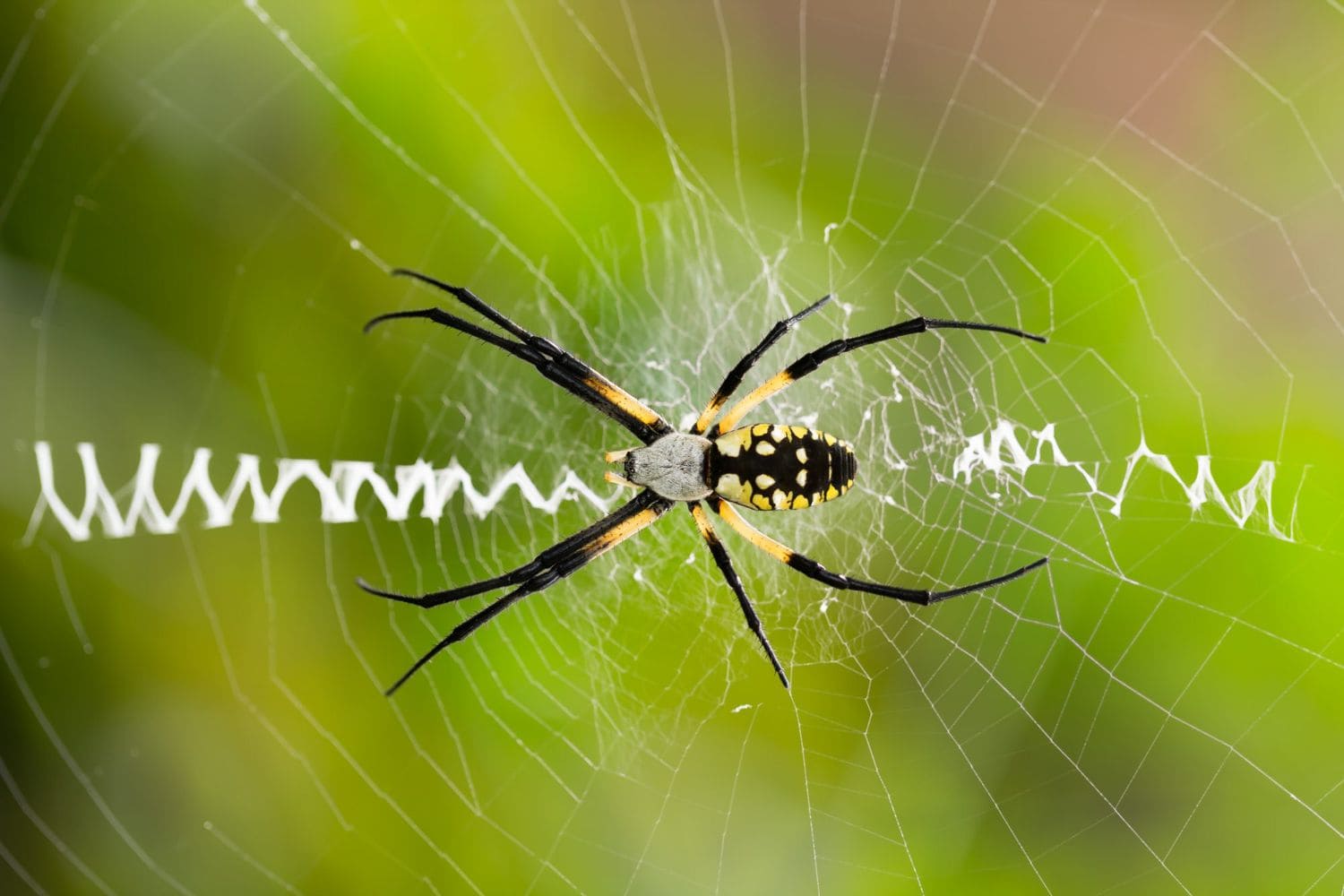I’ll never forget the morning I discovered what looked like nature’s own piece of art hanging between my tomato plants. There, stretched across a perfect circular web adorned with an intricate zig-zag pattern, sat the most striking spider I’d ever seen.
Her abdomen gleamed with bold yellow and black stripes, and she looked like she was wearing tiny yellow stockings on her legs. I stood there with my coffee cup, completely mesmerized, as this beautiful creature went about her morning routine of checking her web for overnight catches.
That was my first encounter with a yellow garden spider, and it completely changed how I thought about the eight-legged residents in my garden. Instead of being something to fear or remove, she became my garden’s most effective and fascinating pest control partner.
If you’ve been struggling with garden pests or simply want to support beneficial wildlife, yellow garden spiders (Argiope aurantia) might just be the allies you’ve been looking for. These remarkable arachnids are nature’s way of keeping your garden balanced, beautiful, and surprisingly pest-free.
Find out The Truth About Wolf Spiders: Friend or Foe in Your Backyard?
Meet Your New Garden Partner
Where You’ll Find Them
Yellow garden spiders are widespread across North America, thriving throughout the continental United States, southern Canada, Mexico, and Central America. They’re most common in the eastern portions of their range but can be found virtually anywhere except the highest elevations of the Rocky Mountains and the coldest regions of Canada.
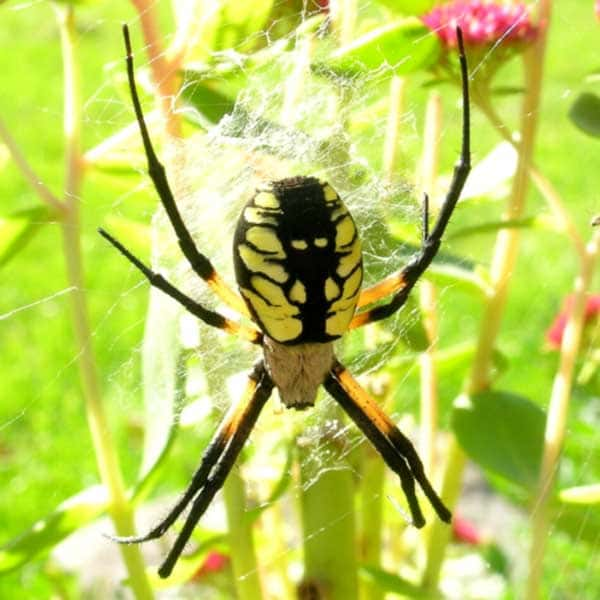
If you’re gardening in most of North America, there’s a good chance these spiders are already in your area, just waiting for the right habitat to call home.
The Artist of the Spider World
Yellow garden spiders are often called “writing spiders” because of the distinctive zig-zag pattern they weave into the center of their webs. This intricate design, known as a stabilimentum, looks like decorative calligraphy written in silk.
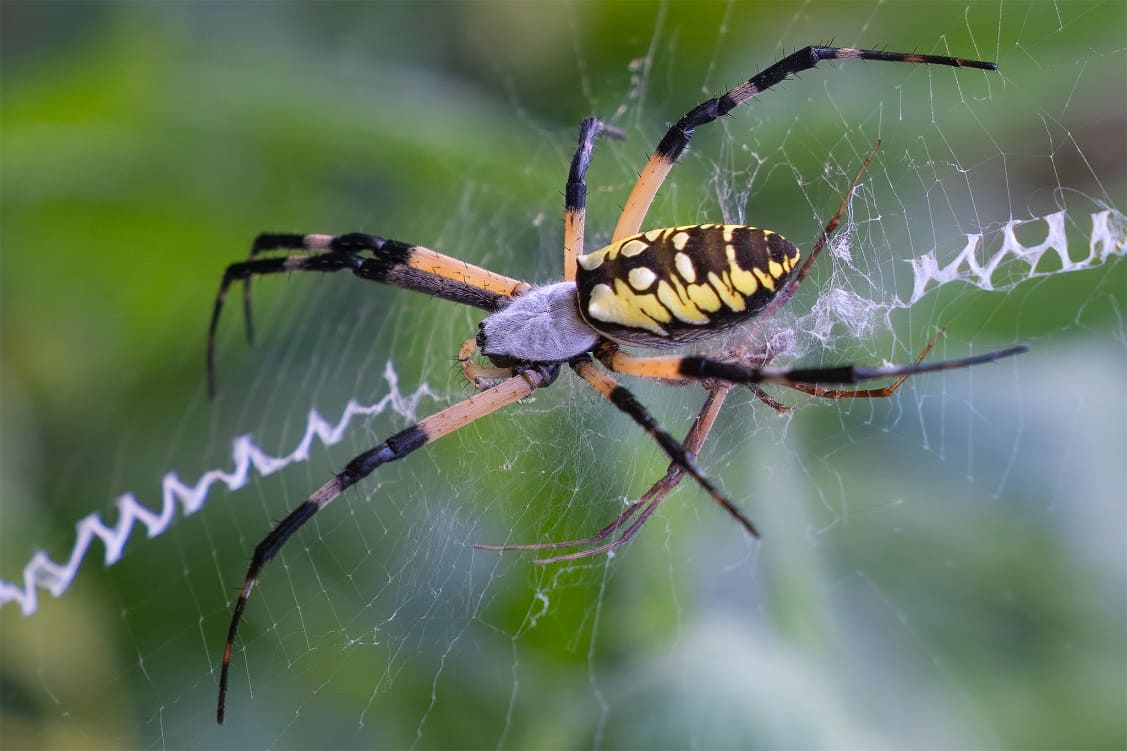
Scientists have proposed several fascinating theories about its purpose: it might reflect UV light to attract prey insects, serve as camouflage to hide the spider from predators, act as a visual warning to prevent birds from flying through the web, or even function as a tiny umbrella providing shade.
While the debate continues, there’s no question it’s one of nature’s most beautiful architectural features.
Impressive Size and Striking Appearance
These orb weavers are impressive in size, especially the females. Adult females can reach over an inch in body length with legs that span nearly three inches, making them among the largest spiders you’ll encounter in North American gardens.
Their bodies display stunning yellow and black markings on a glossy abdomen, with legs featuring alternating bands of black and yellow or orange. The front portion of their bodies (cephalothorax) is covered in silvery-white hairs that shimmer in sunlight.
Males are much smaller and less colorful, typically measuring only about a quarter-inch long. Don’t expect to see them as easily—they spend most of their time roaming around looking for mates rather than sitting prominently in webs.
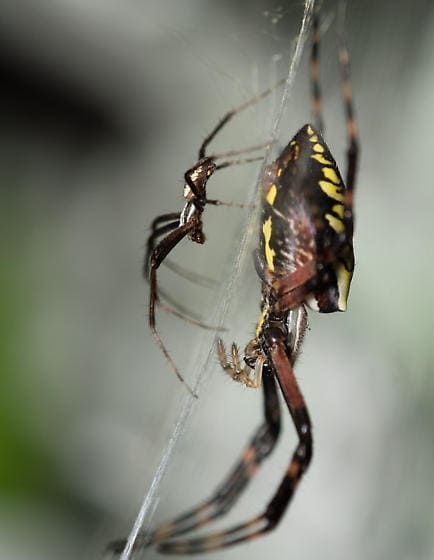
Engineering Marvels: Their Web Construction
The webs these spiders create are truly engineering marvels. A mature female’s web can span up to two feet in diameter, with some exceptional webs reaching even larger dimensions. The silk they produce is incredibly strong—strong enough to occasionally catch small birds, though insects are their intended prey.
Every single night, they consume their entire web and rebuild it from scratch. Watching this process early in the morning is like witnessing a master craftsperson at work.
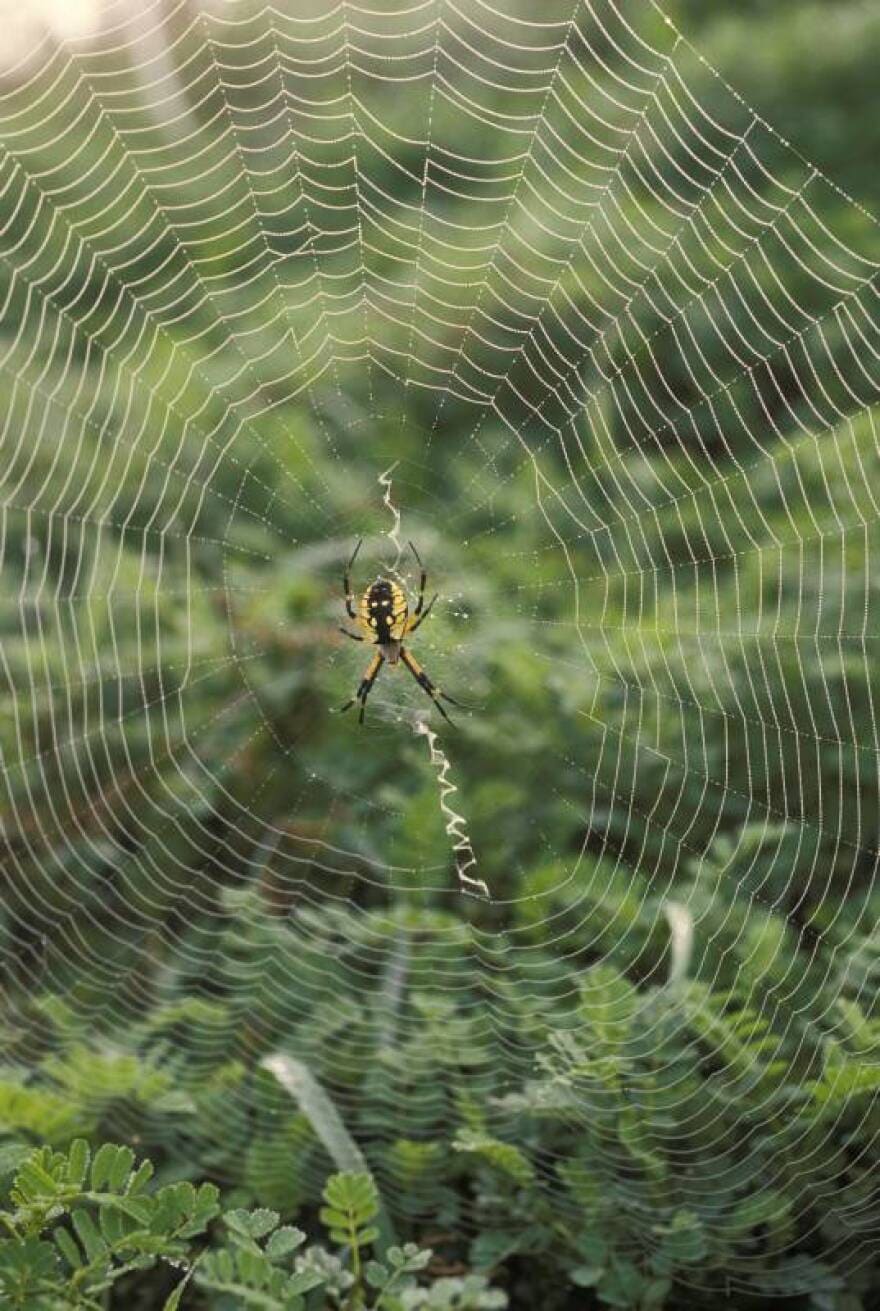
They start with anchor lines that can span several feet, then methodically create the spiral pattern with precise spacing between each ring, finishing with their signature zig-zag centerpiece. The entire process takes just a few hours and results in a structure that can withstand wind, rain, and the struggles of trapped prey.
The Pest Control Powerhouse You Never Knew You Needed
What’s on the Menu?
Your yellow garden spider is basically running a 24/7 all-you-can-catch pest buffet. Their webs regularly capture:
- Mosquitoes and flies that plague summer evenings
- Aphids that damage plant leaves
- Grasshoppers and crickets that munch on crops
- Moths that lay eggs on your vegetables
- Wasps and hornets (yes, really!)
- Beetles that can devastate gardens
- Dragonflies and damselflies
- Various flying bugs that bother both plants and people
I once watched my resident spider catch what I’m pretty sure was a spotted lanternfly—one of those invasive pests that have been causing havoc in many regions.
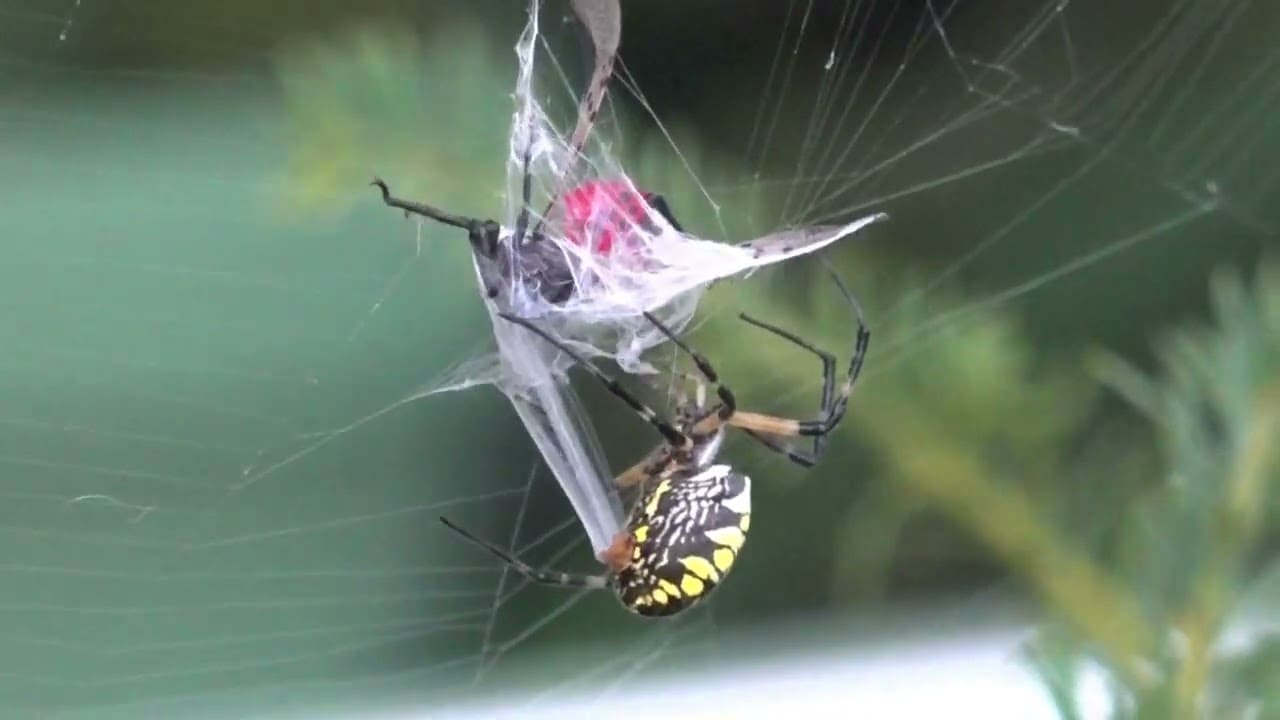
The efficiency was remarkable: web vibrations alerted her to the catch, she raced out to immobilize it with silk using a technique scientists call “throwing” (where she literally throws silk at the prey while keeping her distance), delivered a quick bite, and had it wrapped up for storage in under a minute.
Learn Everything You Need to Know About Huntsman Spiders: Nature’s Pest Controllers
The Numbers Game
A single yellow garden spider can consume dozens of pest insects per day during peak season. When you consider that one spider can live in your garden from spring through the first frost, that’s potentially thousands of harmful insects eliminated without you lifting a finger or spraying a single chemical.
Research has shown that webs with stabilimenta actually catch more prey than those without, making these decorated webs even more effective pest control tools.
Fascinating Defensive Behaviors
When threatened, yellow garden spiders have several remarkable tricks up their eight sleeves. If you gently disturb a web, you might witness “web flexing”—the spider will retreat slightly and begin rhythmically flexing its legs, causing the entire web to vibrate dramatically.
This behavior can dislodge predators, further entangle struggling prey, or make it harder for predators to pinpoint the spider’s exact location.
If the threat is more serious, the spider can drop from its web on a safety line and hide in nearby vegetation, making it nearly impossible for predators to follow.
Creating an Irresistible Spider Habitat
Understanding Their Location Preferences
Yellow garden spiders are particularly drawn to “edge habitats”—areas where two different environments meet. This might be where your lawn meets a flower border, where woods meet a clearing, or where your garden transitions to a wilder area. They prefer sunny locations that get morning light but aren’t exposed to harsh afternoon sun all day.
As spiders mature, their web placement preferences change. Young spiders start close to the ground in sheltered spots, but as they grow larger, they prefer higher locations with better exposure to flying insects—typically 2-6 feet off the ground.
Choose the Right Location
Look for spots in your garden that offer:
- Morning sun with some afternoon protection from the hottest rays
- Steady anchor points that won’t be disturbed by garden maintenance
- Good air circulation where flying insects travel
- Distance from high-traffic areas to prevent accidental web destruction
Ideal locations include areas between tall garden plants and structures, fence posts and garden stakes, shrub branches that won’t be pruned, and spaces near outdoor lighting that attracts their prey at night.
Read The Complete Guide to Hedgerows: Wildlife Havens for Your Property
Plant Their Favorite Anchor Points
While these spiders aren’t picky about specific plants, they do need sturdy structures for their large webs. Research shows they have a documented preference for bush clover (Lespedeza species), but they’ll readily use:
Tall Perennials:
- Joe Pye weed
- Tall asters and goldenrod
- Native grasses like big bluestem
- Black-eyed Susan and purple coneflower

Shrubs with Open Branch Structure:
- Bush clover (their proven favorite!)
- Spicebush and native viburnums
- Rose bushes (especially if you leave hips for winter)
- Elderberry and other native shrubs
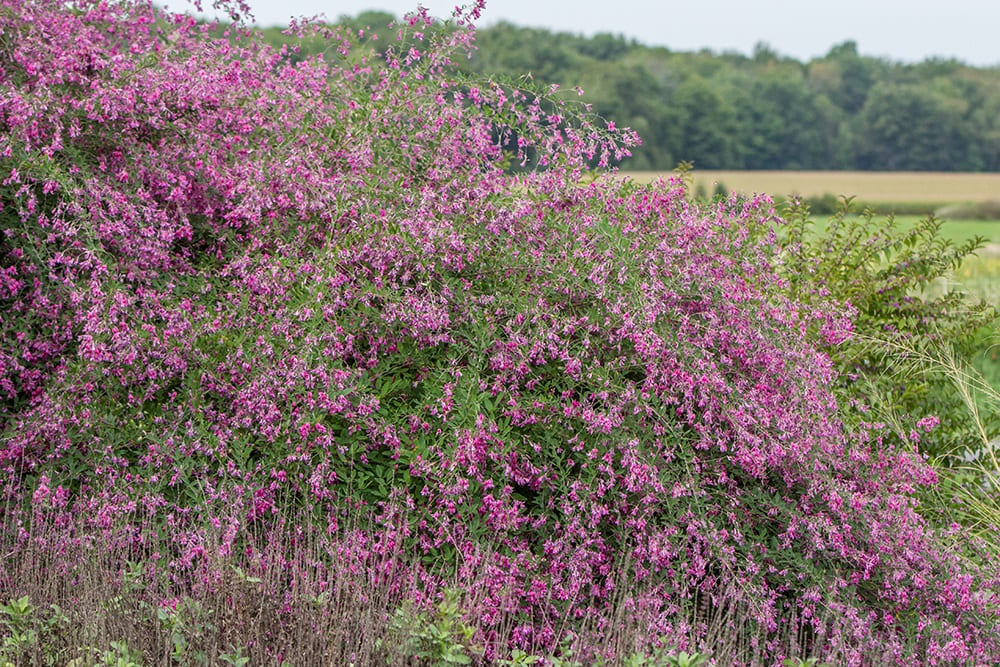
Support Structures:
- Bamboo stakes left in place year-round
- Garden trellises in permanent locations
- Decorative garden posts and arbors
Timing Your Garden for Spider Season
Yellow garden spiders become most noticeable in late summer and early fall, but they’ve actually been growing in your garden since spring. The tiny spiderlings disperse in late spring through a process called “ballooning,” where they release silk strands that catch the wind and carry them to new locations—sometimes for miles.
To welcome new arrivals, avoid excessive garden cleanup in early spring. Those messy corners with tall grass and undisturbed plant debris often harbor overwintering egg sacs. A little wildness in your garden goes a long way toward supporting spider populations.
Create a Diverse Insect Ecosystem
The more varied your garden’s insect population, the more likely you are to attract and sustain yellow garden spiders. This means creating a garden that supports the full ecosystem:
Plant native flowers that bloom throughout the season to attract the diverse flying insects that become spider food. Herbs allowed to flower—like oregano, thyme, and dill—are particularly effective.
Native wildflowers support the complex food webs that sustain healthy spider populations, while a water source like a shallow birdbath adds another layer of insect attraction.
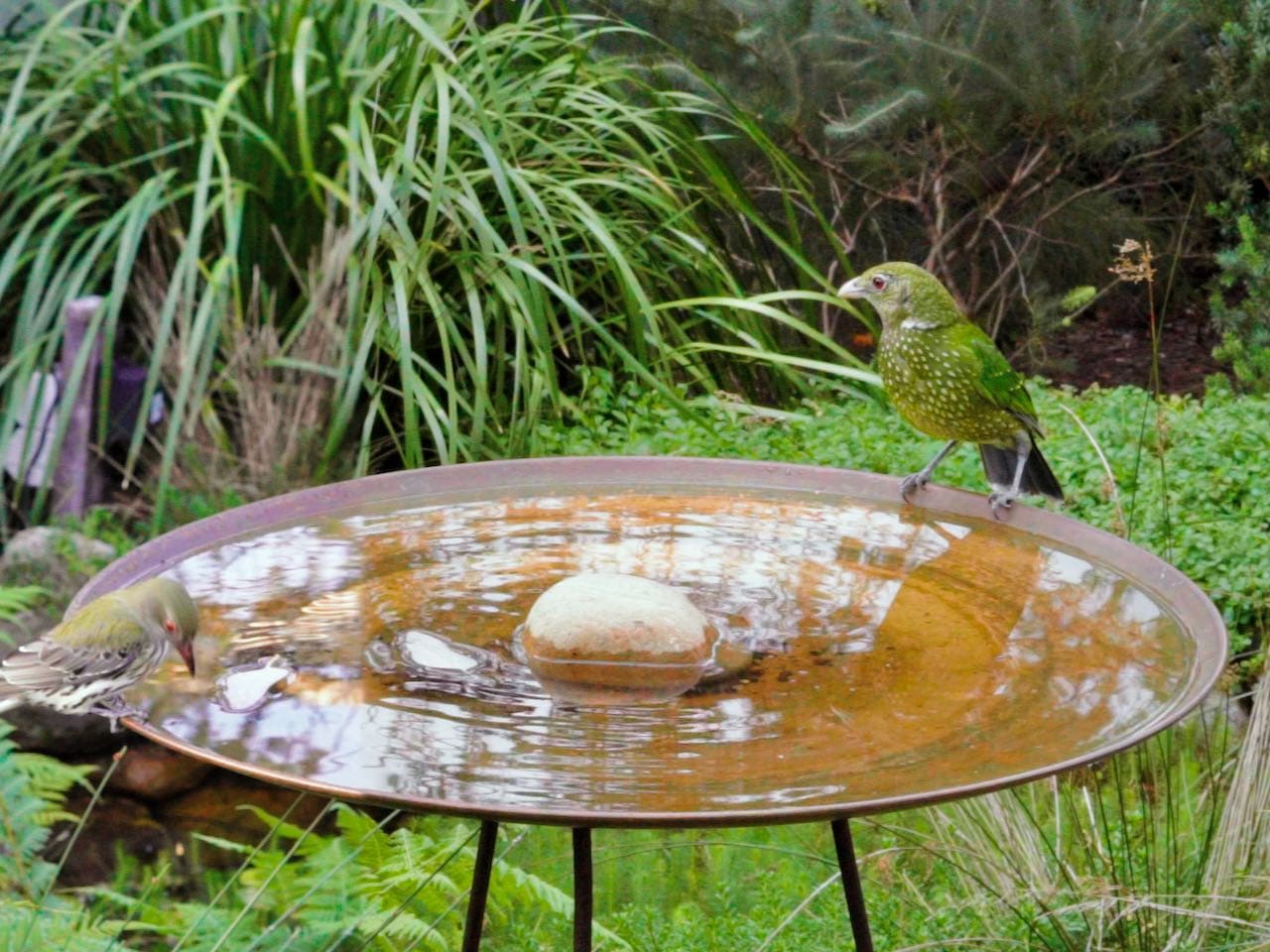
Here’s How to Build a Bee Watering Station: Tips and Ideas for a Bee-Friendly Yard
Understanding Their Natural World
The Circle of Life: Predators and Threats
While yellow garden spiders are formidable predators, they’re not at the top of the food chain. Understanding their natural enemies helps create a balanced ecosystem:
Natural Predators:
- Mud dauber wasps (which specifically hunt spiders)
- Jumping spiders (though they usually target smaller, younger garden spiders)
- Birds (particularly in early morning when spiders are exposed)
- Lizards and toads in areas where they’re present
Environmental Challenges:
- Severe weather that destroys webs repeatedly
- Lack of suitable anchor points
- Insufficient prey populations
- Parasitic wasps and flies that target their egg sacs
Mating and the Next Generation
The mating behavior of yellow garden spiders is both fascinating and somewhat dramatic. Males mature earlier than females and spend late summer searching for mates. When a male finds a suitable female, he builds a small web near hers and courts her by plucking specific vibrations on her web strands—essentially serenading her through silk.
The mating process is risky for males, as they’re much smaller than females and may be mistaken for prey. Remarkably, males often die spontaneously during or immediately after mating, which actually helps ensure their genes are passed on by preventing other males from mating with the same female.
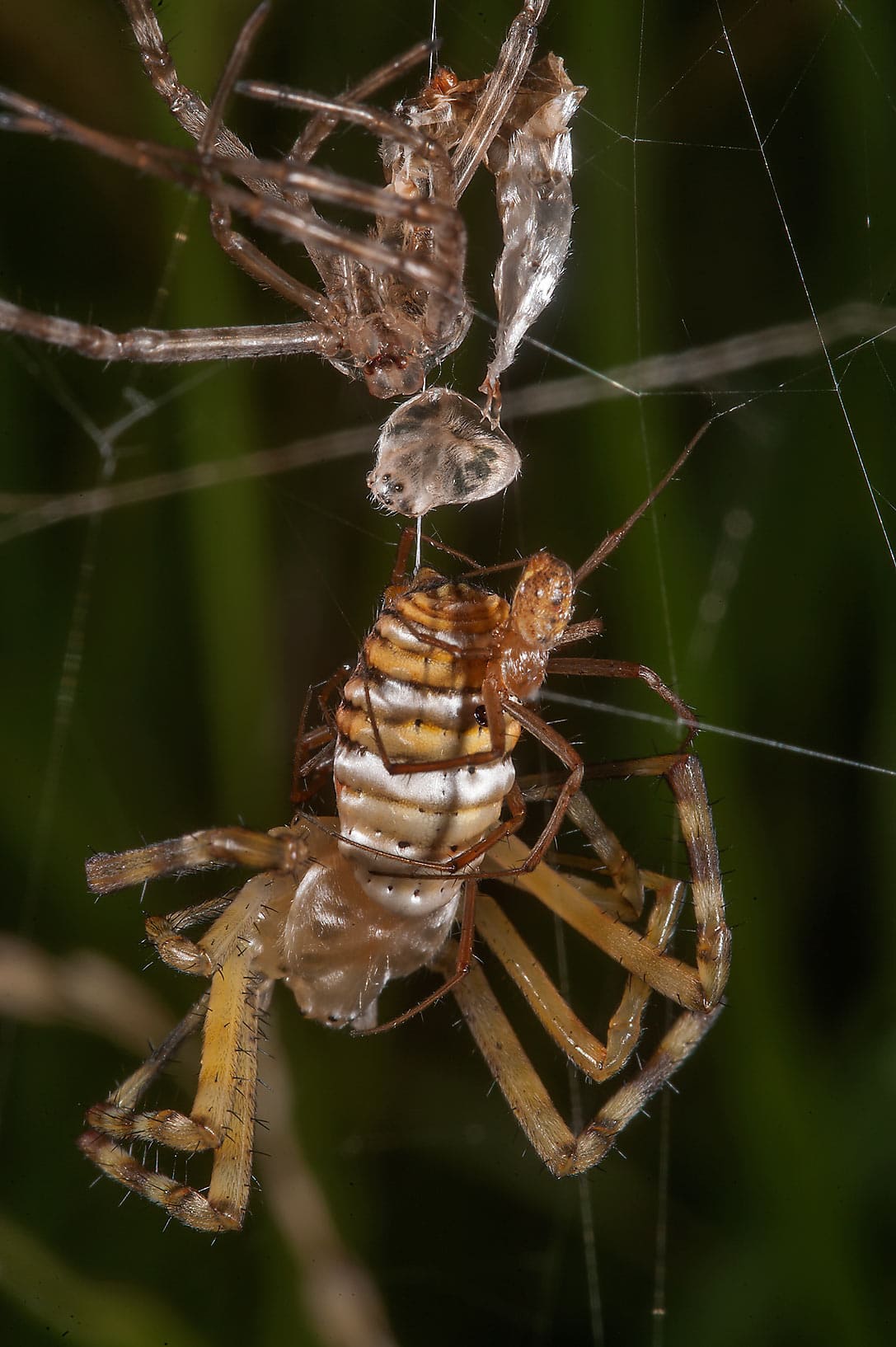
After mating, females create one to four large, brown, papery egg sacs that look somewhat like oversized acorns. Each sac contains 500-1,000 eggs and is carefully placed in protected locations—often under eaves, attached to plant stems, or tucked into dense vegetation. The female guards these sacs until the first hard frost claims her life.
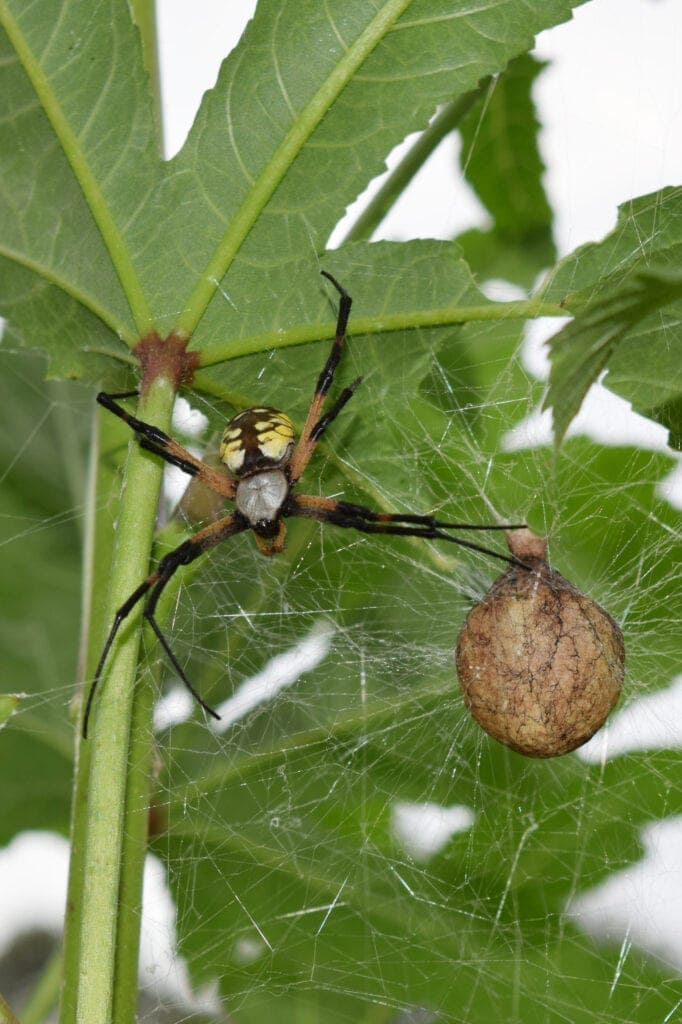
The eggs develop over winter, with tiny spiderlings emerging in spring to begin the cycle anew. Most will disperse by ballooning to find their own territories, but some may settle in the same garden where they were born.
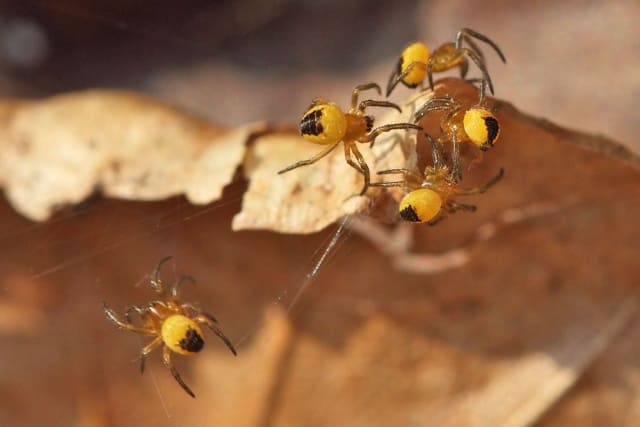
Addressing Common Concerns
“But I’m Afraid of Spiders!”
I completely understand this fear—I used to have it myself. But yellow garden spiders are among the most predictable and non-threatening spiders you’ll encounter.
They spend 99% of their time sitting motionless in the center of their webs, facing downward. They’re not wandering around your house or hiding in corners where you might accidentally encounter them.
Their behavior is so predictable that many people find them less frightening than smaller, more unpredictable house spiders. You always know exactly where they are and what they’re doing.
Safety and Bite Information
Yellow garden spiders are essentially harmless to humans and pets. They’re not aggressive and will only bite if directly handled or trapped against skin. Even then, their bite is comparable to a bee sting—mild pain and perhaps some local swelling for most people.
Their venom is designed to immobilize small insects, not large mammals. While individuals with severe allergies should always exercise caution around any venomous creature, yellow garden spider bites pose no significant medical threat to healthy people.
“Won’t They Attract More Spiders?”
Yellow garden spiders are actually quite territorial and solitary. You’ll typically see only one large female per web, and they don’t live in colonies or family groups. Having one or two in your garden doesn’t mean you’ll suddenly be overrun with spiders—if anything, their presence may actually reduce populations of other, less desirable spider species.
Working with Your Eight-Legged Garden Crew
When and How to Relocate
Sometimes a spider chooses an inconvenient location—right across your garden path or near a frequently used door. Rather than destroying the web, try gentle relocation:
Wait until evening when they’re actively working on their web, use a broom handle to carefully break a few anchor lines, and the spider will usually drop down on a safety line and seek a new location. You can encourage better placement by providing nearby alternatives like garden stakes or plant supports.
Protecting During Garden Maintenance
Late summer garden maintenance can accidentally destroy established webs. Before trimming or harvesting, check for webs early in the morning when dew makes them visible, mark web locations with small flags, plan maintenance routes to avoid spider highways, and leave some “wild” areas undisturbed through fall.
Winter Preparation and Spring Expectations
In late fall, your resident female will create her egg sacs in protected locations. Resist the urge to clean up these brown, papery spheres—they’re naturally designed to survive winter weather and will give you a new generation of pest controllers come spring.
The cycle begins anew each year, with tiny spiderlings dispersing in late spring to establish their own territories. Some may settle right back in your garden if conditions are right.
Frequently Asked Questions
- Q: How long do yellow garden spiders live?
A: Females typically live about one year, reaching maturity in late summer and dying with the first hard frost. Males have shorter lifespans, usually dying shortly after mating. The species survives winter as eggs in protected sacs.
- Q: Will they really help with mosquito problems?
A: Absolutely! Flying insects like mosquitoes are frequently caught in their webs. While they won’t eliminate a severe mosquito problem single-handedly, they’re definitely part of an effective integrated pest management approach.
Here’s How to Use Goldfish for Mosquito Control in Rain Barrels
- Q: What if I accidentally destroy a web?
A: Don’t worry too much—these spiders are incredibly resilient. They rebuild their entire web every night anyway, so destroying it during the day just means they’ll build a new one that evening, often in the same location if they liked the spot.
- Q: Can they bite my pets?
A: It’s extremely unlikely. Yellow garden spiders stay in their webs and only bite when directly threatened. Cats and dogs would have to actively interfere with the spider to provoke a bite, and even then, the venom is harmless to pets.
- Q: How can I tell if I have male vs. female spiders?
A: The large, colorful spiders you notice are almost always females. Males are tiny (about 1/4 the size), less colorful, and spend most of their time wandering rather than sitting in webs. You’re much more likely to spot females in their impressive webs.
Embracing Your Garden’s Natural Balance
Since that first morning encounter with my yellow and black garden artist, I’ve become something of a spider advocate. Every year, I look forward to seeing which parts of my garden the new generation will choose for their homes.
I’ve learned to plan my garden paths around their preferred locations and actually feel disappointed when I don’t see any webs by mid-summer.
These remarkable creatures have taught me that the best pest control often comes from working with nature rather than against it. By providing the right habitat and simply letting them do what they do best, I’ve reduced pest problems significantly while adding an element of living art to my garden spaces.
The next time you spot one of these beauties in your garden, take a moment to appreciate the engineering marvel of their web, the pest control service they’re providing, and the complex behaviors that make them such fascinating neighbors.
With a little encouragement and the right environment, yellow garden spiders can become some of your garden’s most valuable and fascinating residents.
Welcome them in, and watch as your garden becomes a healthier, more balanced ecosystem—one beautiful web at a time.
